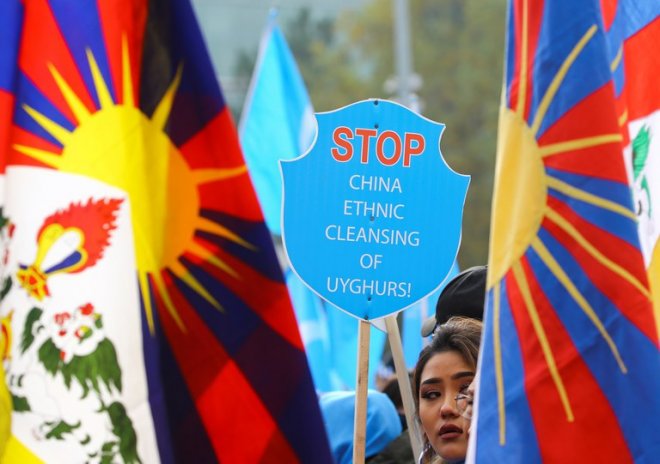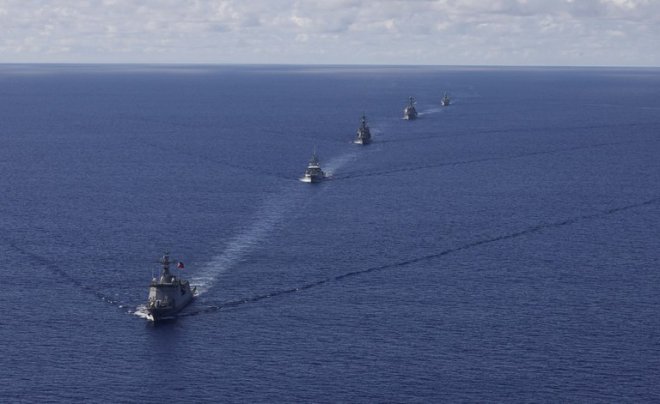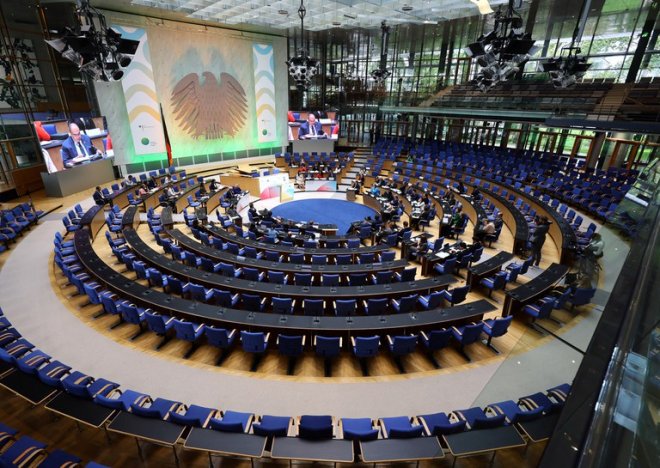INTERVIEW: Beijing’s ‘gray zone’ tactics in the South China Sea
Radio Free Asia sat down for a chat with Raymond Powell, a 35-year veteran of the U.S. Air Force who retired in 2021 and now runs Project Myoushu. Part of Stanford University’s Gordian Knot Center for National Security Innovation, the project seeks to develop tools to counter Beijing’s “gray zone” tactics in the South China Sea.The following has been condensed and lightly edited for clarity.
—
Radio Free Asia: Project Myoushu is about China’s “gray zone tactics” in the South China Sea. Can we start by defining that?
Raymond Powell: We are talking about activities of a state actor – in this case, we"re talking about China – that can"t be directly attributed to them, or which fall in a nebulous legal area where they can act without being directly seen, or noticed, or publicly held accountable.
What makes the South China Sea a hotbed of gray zone activity is that most of what happens there happens outside the public eye. If China, for example, harasses a Filipino fisherman, or points a laser at a Philippine Coast Guard ship, they can attempt to say “That didn"t actually happen, you"re making that up. How do you know it was us?” So what the Philippines has been doing with releasing photos and videos of incidents has been trying to illuminate this gray zone.
Our hypothesis is that if you illuminate gray zone activity, you do two things: You build resilience into your own society against that activity, so that people begin to expect and give you room to push back. And then, also, in the long-term, you hope to deter that activity because now, the gray zone actor – China – is paying a reputational cost.
 Raymond Powell runs a project that seeks to develop tools to counter Beijing’s “gray zone” tactics in the South China Sea. (Provided by Raymond Powell)RFA: Beijing has claimed the South China Sea for a very long time. When did we first see gray zone tactics emerge?
Raymond Powell runs a project that seeks to develop tools to counter Beijing’s “gray zone” tactics in the South China Sea. (Provided by Raymond Powell)RFA: Beijing has claimed the South China Sea for a very long time. When did we first see gray zone tactics emerge?Powell: It"s very hard to put a date on it. I would say that the real sea change in gray zone activities probably can be traced back to the Scarborough Shoal Incident in 2012 – where they essentially took the shoal from the Philippines – and then their island-building campaign, where we saw them turn reefs and rocks into islands and military bases and station Navy and Coast Guard militia ships at those places. They began patrolling around those places in a way that expanded the assertion of their sovereignty. So again it’s hard to put a date on it.
To back up for a second, when I first started looking at the South China Sea in the 1980s, it was very much about “features.” It was about this rock, or this reef, or this island. Everything was centered on who had had actual possession of a particular feature. Obviously, there were overlapping claims, but the thing that mattered was the features.
Now that China has these bases, it is able to project power outwards in a way that it"s very much more about the water, and who has a presence there. It’s about who has an actual military or paramilitary force that is able to push forward into the exclusive economic zones of its neighbors and take possession of things, either physically by rafting a whole bunch of malicious ships together or just by patrolling.
Even patrolling is a gray zone activity, because patrolling by a Chinese Coast Guard ship among Malaysia"s oil and gas activities is an assertion of jurisdiction. It’s saying “We have sovereign rights over your exclusive economic zone, because it falls within our nine-dash line.”
RFA: I’m curious to hear you’ve been looking into the South China Sea since the 1980s. What did it look like then in terms of China’s presence and how has it changed over the last 40 years?
Powell: Because it was mostly about “features,” China"s presence was not actually that noticeable. They had fewer features than, say, the Vietnamese. There was one major clash in 1988 over South Johnson Reef, in which a Chinese ship opened fire on 60 or so Vietnamese sailors who were standing on the reef – actually in the water – but it was very much about who had possession of which feature.
There was not a lot of patrolling happening back then. China simply didn"t have the assets to control all of that water. So that has really changed in the last 15 years, where they have vastly expanded their maritime militia, in particular and their Coast Guard. The Coast Guard and the maritime militia have become their instruments of power projection for the South China Sea. Their maritime militia’s activities are very much gray-zone because they"re very deniable.
They can say, “Well, they"re fishing ships.” But they don"t fish. They exist to patrol or simply to lay claim by sheer presence in an area.
RFA: What about the spate of near-accidents that we’ve seen in the last few years, and particularly in the past few months?
Powell: A similar thing occurred in 2018 with the USS Decatur, which was in the South China Sea doing a freedom of navigation operation. It was similar in that the Chinese ship attempted to cut off the United States ship, and in both cases they came very close to doing so. More recently, we saw a Philippine Coast Guard vessel that was outside of Second Thomas Shoal also nearly collide with a Chinese ship.
What is different now – in particular when you"re talking about the Philippines – is that the Philippines is releasing the photos and the video of the incidents. I think that is actually a quite effective deterrent measure, because part of China"s model for gray zone activity is that it’s just meant to be a message for the Philippine government, but now it"s exposed for the world and they have to recalculate its value.
 An activist burns a flag of China during a protest to demand that the Chinese government pull out from the Scarborough Shoal during a rally in front of the Chinese consular office in Makati"s financial district of Manila, May 8, 2012. (Cheryl Ravelo/Reuters)RFA: What is the message that they"re trying to send to the Philippines, and to the United States when it happens with U.S. ships and planes? How does publicizing it alter the calculus?
An activist burns a flag of China during a protest to demand that the Chinese government pull out from the Scarborough Shoal during a rally in front of the Chinese consular office in Makati"s financial district of Manila, May 8, 2012. (Cheryl Ravelo/Reuters)RFA: What is the message that they"re trying to send to the Philippines, and to the United States when it happens with U.S. ships and planes? How does publicizing it alter the calculus?Powell: When it’s a gray zone activity, generally speaking, the message is to the government of the country involved, and the message is: “You don’t want to escalate this. You want to have your relationship with China be as uncomplicated as possible. So now that you know we’re the jurisdiction here, keep this between us.”
What publicizing the incidents does is impose a reputational cost on China for doing those kinds of things. For many governments, the temptation is to go along, be quiet and not publicize anything, because you want everything to go back to normal. The problem is that the creeping normal is becoming less and less and less favorable for the region and for the other Southeast Asian countries.
So the more you normalize the gray zone activity, the more they simply become expected, and eventually you will normalize yourself right out of all of your own legal and internationally lawful rights to your own exclusive economic zone. That is the tactic they call “salami slicing” – you take a slice of salami, another slice and another slice.
So every time they sail through your waters and do a survey or a petrol, or they harass your oil and gas operations, or they stop your fisherfolk from fishing, and you acquiesce, it brings into normalcy the fact that you are no longer in charge of your own waters.
RFA: It’s changing “the facts on the ground.”
Powell: Right. So bringing it back to the U.S., one of the things that China does not like at all is U.S. freedom of navigation operations. The entire reason the freedom of navigation operations exist – and have existed for over four decades – is for this exact circumstance.
Because if you allow a country to say “I"m going to draw a circle around this thing right here, which does not have a status under international law, but I"m going to say it belongs to me and nobody is allowed in here without my consent,” and we say, “Okay, the facts on the ground have now changed, even if the legal status has not,” then we have acquiesced. We"ve said that we will not go where you tell us not to go.
The problem with that is it doesn’t have a logical stopping point. So the reason that freedom of navigation operations exist is that we simply say we will go wherever international law allows us. If the law allows us to go, say, in a straight line through this area, or to do maneuvers in that area, we will do exactly that, simply as an assertion of our rights.
RFA: So when China says it’s provocative, that’s the point?
Powell: I used to have diplomatic friends on the Chinese side say, “But why do you have to go through these very sensitive areas? The South China Sea is so big, you can easily go to other areas.” But you can"t just say something is sensitive to you and make a circle around it, and deny other people their right to go there. Eventually what will happen is that international law has no meaning, and might simply makes right.
A freedom of navigation operation is a specific thing that is meant to counter excessive maritime claims. It’s very narrowly defined. The thing to remember is it"s not unique to the South China Sea or to China. We do freedom of navigation operations against excessive claims in the Mediterranean Sea, and against allies who have excessive claims. Some of them may write a protest letter to the embassy. We will file it and it goes unremarked on. Only China reacts the way that they do.
 In this photo provided by the U.S. Navy, the USS Chung-Hoon observes a Chinese navy ship conduct what it called an "unsafe” Chinese maneuver in the Taiwan Strait, June 3, 2023, in which the Chinese navy ship cut sharply across the path of the American destroyer, forcing the U.S. ship to slow to avoid a collision. (Mass Communication Specialist 1st Class Andre T. Richard/U.S. Navy via AP)RFA: Do you think that part of the submarine sale to Australia under the AUKUS deal, in spite of the massive backlogs at U.S. shipyards, is meant to expand who’s doing these operations?
In this photo provided by the U.S. Navy, the USS Chung-Hoon observes a Chinese navy ship conduct what it called an "unsafe” Chinese maneuver in the Taiwan Strait, June 3, 2023, in which the Chinese navy ship cut sharply across the path of the American destroyer, forcing the U.S. ship to slow to avoid a collision. (Mass Communication Specialist 1st Class Andre T. Richard/U.S. Navy via AP)RFA: Do you think that part of the submarine sale to Australia under the AUKUS deal, in spite of the massive backlogs at U.S. shipyards, is meant to expand who’s doing these operations?Powell: It"s very hard for a country to just start doing them.
RFA: But Australia does do freedom of navigation operations, even if not as frequently as the United States.
Powell: This is a technical question. Under the U.S. definition of a freedom of navigation operation, there are certain classifications. So, for example, Australia does not go within 12 nautical miles of a Chinese-held feature in the South China Sea. We do. Australia does not go through the Paracel Islands, around which China draws what we call straight baselines and says “You can"t go in here.” We do.
Oftentimes, my Australian friends would say, “Well, we do them, we just don"t go within 12 nautical miles.” But those are the ones that meet the technical definition of what our program calls “freedom of navigation operations.” So when my Australian friends would say “We do them,” I say that we"re using different definitions of the term.
Australia has operations in the South China Sea, which they will say asserts their freedom to navigate the South China Sea. They will not, though, go the next step of going within 12 nautical miles of a feature. I understand why – because the first time that they do, everyone will notice and will want to know who they did it against. And if they do it against China, then China will treat it very much as a provocation.
 A Philippine flag is seen between Philippine Navy ships at the Philippine-claimed island of Thitu, locally known as Pag-asa island at the South China Sea, April 21, 2023. A Chinese navy ship shadowed the two Philippine patrol vessels in the darkness after midnight as they cruised near Subi, one of seven barren reefs that China has transformed into bases in the past decade. (Aaron Favila/Associated Press)RFA: It sounds like you’re saying the “salami slicing” is working, if Australia is unable to go near these Chinese-held features?
A Philippine flag is seen between Philippine Navy ships at the Philippine-claimed island of Thitu, locally known as Pag-asa island at the South China Sea, April 21, 2023. A Chinese navy ship shadowed the two Philippine patrol vessels in the darkness after midnight as they cruised near Subi, one of seven barren reefs that China has transformed into bases in the past decade. (Aaron Favila/Associated Press)RFA: It sounds like you’re saying the “salami slicing” is working, if Australia is unable to go near these Chinese-held features?Powell: Yes, you can say that China has – to every country in the world except for the United States – successfully been able to draw a 12 nautical mile circle around a number of claims, and say that nobody else can come close to them. They’ve sliced the salami that far.
RFA: How do you see this developing by 2030? What discussions will be taking place in Washington about the South China Sea?
Powell: If everything sort of stays on its current trajectory, the danger is that China consolidates its claims simply by increasing the number and frequency of its patrols, and essentially pushes its claim all the way to the edges of the nine-dash line, so that it becomes the effective sheriff, if you will, or the effective constabulary for the entire nine-dash line.
In some ways, they"ve already done that in many places. For example, the Philippines cannot fish at Scarborough Shoal except for in the way specifically allowed by China. China has not yet been able to entirely push that into, for example, hydrocarbon fields like Vietnam’s Vanguard Bank, or Malaysia"s of Luconia Shoals. But it has stopped any new exploitation there, if ever somebody wants to survey a new area.
There are a couple of flashpoints. One is that the Philippines is running out of natural gas from its existing gas fields, and it believes that it has exploitable natural gas at Reed Bank, which is within the nine-dash line. At some point, there will be an increasingly acute need to address that in some way that doesn’t violate the Philippines’ sovereignty.
Another is that the Philippines has a ship, the BRP Sierra Madre, which they ran aground in 1999 at Second Thomas Shoal. It effectively serves as their outpost there and asserts the Philippines’ claim over the shoal, which is in their exclusive economic zone. That ship is getting very old and increasingly rusted and brittle, and China has been very effective in not allowing repairs. At some point, that ship could easily begin to break up, or to slide off the shoal, which could provoke a crisis: What would the Philippines and its U.S. ally do about that?
RFA: Everything you"re saying is leading me to think that there"s two possible conclusions: Either China does take control over the nine-dash line area of South China Sea, or there will be some kind of conflict with the U.S. military. Is there a third option?
Powell: Even under President Xi Jinping, it is not in China"s national interests to be in a constant state of tension and conflict with every country, everywhere, all the time, over everything.
 The Arleigh Burke-class guided-missile destroyer USS Milius (DDG 69) conducts routine operations in the South China Sea, March 24, 2023. China threatened “serious consequences” after a U.S. destroyer sailed around the disputed Paracel Islands in the South China Sea for the second day in a row. (Mass Communication Specialist 1st Class Greg Johnson/U.S. Navy via AP)At some point it has to decide which battles it really wants to fight. So it’s in the interests of each country along its periphery to see if they can push back to the point where China realizes it’s not in its interests to have constant tension and there is instead a settlement somewhere short of yielding sovereignty over the entire nine-dash line.
The Arleigh Burke-class guided-missile destroyer USS Milius (DDG 69) conducts routine operations in the South China Sea, March 24, 2023. China threatened “serious consequences” after a U.S. destroyer sailed around the disputed Paracel Islands in the South China Sea for the second day in a row. (Mass Communication Specialist 1st Class Greg Johnson/U.S. Navy via AP)At some point it has to decide which battles it really wants to fight. So it’s in the interests of each country along its periphery to see if they can push back to the point where China realizes it’s not in its interests to have constant tension and there is instead a settlement somewhere short of yielding sovereignty over the entire nine-dash line.RFA: That sounds like a far way off.
Powell: Every country needs to be thinking in the long-term.
In the short term – and this goes back to the point of our program – countries like the Philippines can use transparency into gray-zone tactics as their friend. There is something to be gained, because it forces China to recalculate the cost/benefit of pushing that hard.
There"s an old saying that is attributed to Vladimir Lenin: “Probe with the bayonet. If you meet steel, withdraw. If you meet mush, press forward.” You need to have some steel in there, so that they know how hard they can push before you will start pushing back.
|
本篇 |
不想錯過? 請追蹤FB專頁! |
| 喜歡這篇嗎?快分享吧! |
相關文章
AsianNewsCast
























